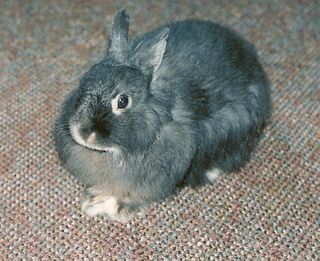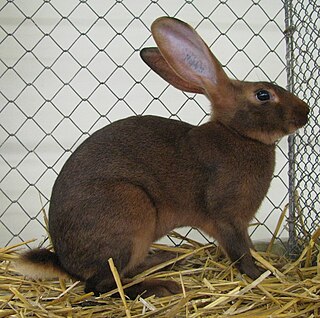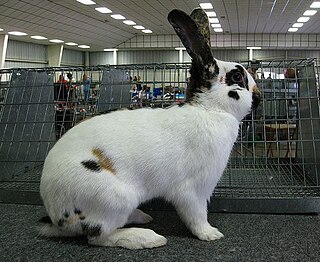
The Jersey Wooly is a breed of domestic rabbit weighing about 3 pounds with a bold head and wool fur on their body.

Dwarf rabbit refers either (formally) to a rabbit with the dwarfing gene, or (informally) to any small breed of domestic rabbit or specimen thereof, or (colloquially) to any small rabbit. Dwarfism is a genetic condition that may occur in humans and in many animals, including rabbits. True dwarfism is often associated with a cluster of physical abnormalities, including pituitary dwarfism. The process of dwarfing is used to selectively breed for smaller stature with each generation. Small stature is a characteristic of neoteny, which may account for the attraction of dwarf animals.

Rabbit show jumping, also known as rabbit agility or rabbit hopping, is an animal sport wherein domestic rabbits are led through a course by their owners, modelled after horse show jumping. It is typically conducted in a closed, indoor arena, with obstacles scaled to suit the rabbits. Competitions have been held in the United States and several European countries. As rabbits are common domestic pets, some owners train their pet rabbits for this sport.

The Mini Lop is a breed of domestic rabbit that is recognized by the American Rabbit Breeders Association (ARBA). It is different from the Miniature Lop breed that is recognized by the British Rabbit Council (BRC). The Mini Lop [US] and the Miniature Lop [UK] are different from the Dwarf Lop breed that is recognized by the BRC. The Mini Lop is similar to several other small rabbit breeds, such as the Dwarf rabbit.

The American Fuzzy Lop is a rabbit breed recognized by the American Rabbit Breeders Association (ARBA). It is similar in appearance to a Holland Lop. However, the American Fuzzy Lop is a wool breed and will have wool similar to the Angora breeds although the wool will be shorter than that of a commercial Angora. The American fuzzy lop has to weigh up to four pounds in order to be shown.

The term rex rabbit refers informally to one of at least eight breeds of domestic rabbit. One such breed is the Rex, which is recognized by the American Rabbit Breeders Association (ARBA) and by the British Rabbit Council (BRC). Other modern-day rex rabbit breeds are listed below. Care must be taken to distinguish the rex rabbit breeds from the three types of rex rabbit fur for which they are known.

The American Rabbit is a breed of rabbit, recognized by the American Rabbit Breeders Association (ARBA) in 1917. According to the ARBA Standard of Perfection, American rabbits have a mandolin body shape. It has also been noted for a docile temperament and good mothering abilities. As with all domestic rabbits, the American breed is of the species Oryctolagus cuniculus, the European wild rabbit.

The Checkered Giant, known as Géant Papillon in French, is a breed of domestic rabbit that originated in France. One of the largest rabbit breeds, the Checkered Giant is recognized by the American Rabbit Breeders Association (ARBA). The Checkered Giant is one of the minority of rabbit breeds with specific coat markings. The markings defined in the breed standard of the Checkered Giant differ somewhat from those in the breed standard of the Giant Papillon. For ARBA show purposes, a mature Checkered Giant buck must weigh a minimum of 11 pounds (5.0 kg), and a mature doe must weigh a minimum of 12 pounds (5.4 kg). ARBA does not specify a maximum weight for Checkered Giants.

The Argenté rabbit is one of the oldest breeds of French show rabbits. The British Rabbit Council (BRC) recognises six varieties: Argenté Bleu, Argenté Brun, Argenté Crème, Argenté de Champagne, Argenté Noir, and Argenté St Hubert. The American Rabbit Breeders Association (ARBA) recognises the Champagne d'Argent, the Crème d'Argent and the Argenté Brun. A rare variety, the Argenté Clair, is not currently recognised by either the BRC or ARBA.

The Belgian Hare is a "fancy" breed of domestic rabbit. It has been selectively bred to resemble the wild European hare, but nevertheless, it is a rabbit rather than a true hare. Averaging 6–9 pounds (2.7–4.1 kg), the Belgian Hare is known for its slender and wiry frame and its long and powerful legs. The breed is responsible for launching the domestic rabbit industry, as well as popularizing rabbit shows in the United States.
The American Cavy Breeders Association (ACBA) is a national specialty club under the America Rabbit Breeders Association (ARBA). Like many other specialty clubs under ARBA, the ACBA maintains a membership, awards sweepstakes points, provides special awards, publishes a newsletter and contributes to developing new standards. The ACBA has wider responsibilities than other specialty clubs under ARBA because it is the only national specialty club for cavies and supports all currently recognized breeds, whereas most of the other ARBA national specialty clubs are devoted to a single rabbit breed. The exceptions are a handful of very similar breeds with combined clubs.

The Silver Fox rabbit is a rare breed of domestic rabbit developed by Walter B. Garland of North Canton, Ohio, and bred for meat, show, and its unique fur. The breed is recognized by the American Rabbit Breeders Association.

The Tan rabbit is a small fancy breed of rabbit shown throughout the world. While originally from England, it has gained popularity in the United States. Tans come in four varieties: black, blue, chocolate and lilac. Full grown Tans weigh 4-6 pounds.

The Rhinelander is a medium-sized breed of domestic rabbit that originated in Germany. Rhinelanders are known for their distinctive facial "butterfly markings", a spine marking, colored ears, cheek spots, eye circles and side markings of black with orange or of blue with fawn. The Rhinelander breed is recognized by the British Rabbit Council (BRC) and by the American Rabbit Breeders Association (ARBA).

The Florida White is a relatively small breed rabbit originally produced for the laboratory or smaller meat rabbit. They are all white in color with no other markings, and have Albino red eyes. They are a recognized American Rabbit Breeders Association (ARBA) breed.

The Silver rabbit is a rare breed of domestic rabbit believed to be brought to England by Sir Walter Raleigh in 1592. The breed has been bred for meat, show, and its pelt ever since and is recognized by the American Rabbit Breeders Association (ARBA).
The Blue Imperial rabbit was an English breed of domestic rabbit that is now extinct. It was originally bred by Miss Mabel Illingworth (1879-1955), who was the first woman to create a rabbit breed. It was used to create several modern breeds, including the American rabbit.

A rabbit show is a type of animal show where rabbits are exhibited. Most rabbit exhibitions in America are sanctioned by the American Rabbit Breeders Association (ARBA), which recognizes 52 breeds in its Standard of Perfection 2021–2025. Rabbit show jumping, also known as rabbit hopping or rabbit agility, is a performance sport developed in the 1970s based on horse jumping and is distinct from traditional rabbit shows. Rabbit shows are mainly oriented towards exhibitors, rather than spectators, and receive little publicity compared to rabbit show jumping. Exhibitors display rabbits at shows for prize money and other awards.
















